Contents
Market Overview
Macro Review
Higher U.S. inflation, but Powell didn’t blink. Chair Powell’s dovish remarks in front of the House and Senate kept rates in check, which bull flattened 7bp this week as stronger core inflation touched 4.5% y/y. China’s industrial production, fixed asset investment and retail sales slowed, but beat market expectations while 2Q GDP was just shy of consensus at 7.9% y/y. Meanwhile, Saudi Arabia and the UAE agreed on baseline concessions, which could break the OPEC+ disagreement, although Iraq has sought further concessions as crude declined 2.8% on the week. Delta concerns were also spreading with stricter lockdowns across Continental Europe, South-East Asia and Australia, just as the UK seeks to ease most restrictions on “Freedom Day” (Monday). In terms of G10 hawkishness, New Zealand stood out as the RBNZ will immediately end its “Large Scale Additional Purchasing” program, rather than tapering as per the Bank of England and Bank of Canada, which is heavily expected by the Federal Reserve in 4Q21 or 1Q22. South African asset markets were rattled by protests, although volatility was contained as ZAR weakened 1.5% (more below).
EM Credit Update
EM sovereign credit ended the week up 0.2% with spreads 3bp wider. U.S. Treasuries bull flattened where 2-3yr tenors were 2-6bp wider, but 10-30yr rates were 3-4bp tighter. The 5s30s U.S. Treasury curve is now at 113bp, which is 7bp tighter this week. In secondary market, Zambia, Suriname and Slovakia outperformed, while El Salvador, Tunisia and Ecuador lagged.
The Week Ahead
Next week the ECB will offer clarity on its strategy review, which extends across communication on interest rates, bond buying (transitioning away from PEPP) and importantly alternative tools to manage its new inflation strategy. Beyond that, China’s surprise RRR cut earlier this month increases the focus on the PBoC with 1yr and 5yr MLF rates at 3.85% and 4.65%, where we will also have rate decisions out of Indonesia (3.5%), Russia (5.5%) and South Africa (3.5%). South Africa’s CPI is expected to slow to 4.8%, although the SARB will offer more current commentary around the impact after recent protests/looting (growth is expected to moderate too). Other inflation releases are due from Brazil, Hong Kong, Mexico and Singapore.
Highlights from emerging markets discussed below include: Protests in South Africa test President Ramaphosa and increase uncertainty; Solid China 2Q GDP print supports view that RRR cut was preemptive and fine-tuning of policy; Colombia’s government presents watered down tax reform proposal, reflecting a challenging socio-political environment ahead of critically important elections in 2022; and Global emerging markets corporates in focus: Going…hungry?
Fixed Income
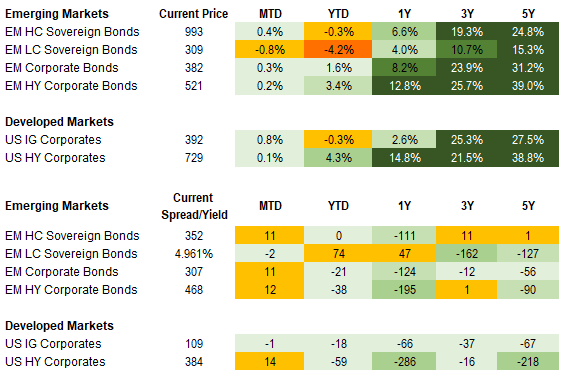
Equities
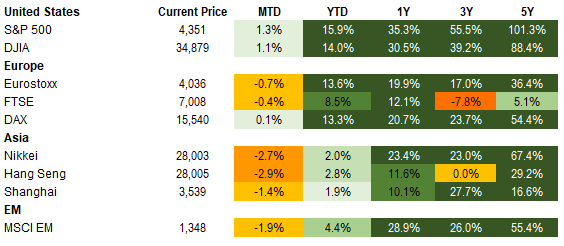
Commodities

Source for data tables: Bloomberg, JPMorgan, Gramercy. EM Fixed Income is represented by the following JPMorgan Indicies: EMBI Global, GBI-EM Global Diversified, CEMBI Broad Diversified and CEMBI Broad High Yield. DM Fixed Income is represented by the JPMorgan JULI Total Return Index and Domestic High Yield Index. Fixed Income, Equity and Commodity data is as of July 16, 2021 (Mid Afternoon).
Emerging Markets Weekly Highlights
Protests in South Africa test President Ramaphosa and increase uncertainty
Event: Unrest erupted this week initially in response to the jailing of former President Jacob Zuma and then exacerbated by challenging underlying economic conditions and COVID-19. At the time of writing, a majority of the protests remained localized in KwaZulu-Natal and to a lesser extent Guateng with increased deployment of military troops to the impacted areas and more broadly on a preventive basis. The rand was weaker by 2.5% on the news with some retracing by the end of the week.
Gramercy Commentary: While the situation remains fluid and complicates Ramaphosa’s governability, the containment of protests thus far coupled with military support bolsters odds for easing in unrest in the coming weeks. The recent positive political momentum behind Ramaphosa following suspension of Secretary General Ace Magashule, key rival and Zuma supporter, should remain intact albeit partially eroded by this development. Depending on the duration of the unrest and closure of roads and/or ports, coupled with near term growth headwinds from virus related measures, the market consensus growth forecast of 4.5% could face downside risks, following upward revisions through 1H on positive external dynamics. The economic impact should have moderate pass through fiscal implications related to revenue, partially offsetting previous outperformance, but we do not envisage material changes on the expenditure side relative to budget. Associated regional food shortages pose a risk to prolongation and deepening of discontent but should not alter the SARB policy in the near term. If the situation stabilizes, local assets should retrace losses, all else equal, albeit likely with a moderately less robust anchor for FX relative to 1H.
Solid China 2Q GDP print supports view that RRR cut was preemptive and fine-tuning of policy
Event: Real GDP growth expanded 7.9% y/y in 2Q, which is just shy of expectations of 8.0% y/y but outperformed consensus in sequential terms with a m/m increase of 1.3% vs. 1.0% median forecast and 0.6% in 1Q. Retail sales and industrial production for June were slightly better than anticipated.
Gramercy Commentary: Activity in the second quarter was a continuation of robust external performance with improvement in consumption and services although still lagging amid ongoing pandemic and structural headwinds. We see recent data, combined with refinement of monetary policy and some stabilization in the credit tightening, supportive of existing full year growth assumptions of around 8% y/y. While vaccination momentum has increased, the lower efficacy of Sinopharm leaves the country partially reliant on traditional distancing measures in a backdrop of more transmissible variants and thus contributes to prospects for a nuanced approach to policy for 2H.
Colombia’s government presents watered down tax reform proposal, reflecting a challenging socio-political environment ahead of critically important elections in 2022
Event: Minister of Finance Jose Manuel Restrepo unveiled this week a revamped tax reform proposal to be re-submitted to parliament on July 20.
Gramercy Commentary: The original tax reform proposal presented by the Duque Administration in late April plunged the country into major social unrest, including road blockades and weeks of street violence. As such, it is unsurprising that the amended proposal has been significantly watered down from its original version and now does not include the most socially sensitive elements such as broadening Colombia’s relatively narrow tax base and eliminating VAT exceptions. The government is targeting much less aggressive revenue increases and the bulk of the adjustment would come from a proposed hike in the corporate tax rate to 35% from 30%, starting in 2022. Overall, if approved, the package is projected to deliver around 1.2% of GDP in structural fiscal savings, which is relatively insignificant in the context of Colombia’s large fiscal deficit (~7.5% of GDP projected for 2021). The watered down tax reform proposal reflects severely eroded political capital of the current administration and major social/political constraints that exist on delivering tough (but necessary) economic reforms in the current environment. Amid political and social obstacles to fiscal consolidation, the government lost its coveted Investment Grade credit rating from Fitch on July 1, having already been downgraded to HY by S&P in May. In addition, next year Colombia faces elections for Congress (March) and President (first round in May), which limits any remaining window and appetite for reforms even further. Provided “tax reform right” is approved by the end of August, the government’s stated target, we expect that market focus will shift almost entirely to the looming 2022 elections with investors evaluating the risks of a structural change in Colombia’s economic policy environment in the event of a political shift to a left-wing administration. Gustavo Petro, a leftist former mayor of Bogota, who lost by around 2mm votes against Ivan Duque in the 2018 Presidential runoff, appears well positioned to be a leading candidate in 2022, according to early polls. The overall social and political climate in Colombia and Latin America in general in the post-COVID era should also make Petro a stronger candidate relative to 2018, in our view.
Global emerging markets corporates in focus: Going…hungry?
Event: In the latest edition of The State of Food Security and Nutrition in the World (SOFI 2021), the UN estimates that about a tenth of the world’s population was undernourished in 2020. This increased from 8.4% in 2019. The UN states that the COVID-19 pandemic may explain much of this. The report further estimates that over 2.3 billion people, 30% of the global population, do not have year-round access to adequate food. It is projected that the Sustainable Development Goal of zero hunger by 2030 will be missed by a margin of almost 660 million people. The humanitarian impact of this is enormous. Emerging market corporates may not be left unscathed.
Gramercy Commentary: Reports of increased food bank use in some developed markets suggest that rising food insecurity is not just an emerging markets problem. Food insecurity is also not new – it has been a focus for many decades, though the UN report does highlight that world hunger hit a 15-year high in 2020. With food insecurity more prevalent, there are a number of implications for emerging market corporates. Firstly, this likely increases the focus on ESG-related activities. Specifically, issuers’ social programs may receive more attention and, to the extent that climate change and adverse weather are seen as contributing to food shortages, environmental metrics may increase in importance. Food insecurity, which may well be caused by food price inflation exceeding changes in wages, may also impact the productivity of employees. There may be implications for asset quality as well – put simply, it is less likely that loans or other borrowings will remain current if basic needs such as food are not sufficiently covered. Further, the demand for non-essentials may fall, impacting revenues and other metrics at issuers producing these goods or offering such services. The potential short, medium and long-term impact of food insecurity on health outcomes, life expectancy and population growth cannot be understated. This has implications for growth, and may impact healthcare providers and insurers. Food producers, on the other hand, may be seen as benefiting where food insecurity results from higher prices. However, a corresponding decrease in sales volumes may offset this. In addition, those operating in the food sector may still face supply bottlenecks as a result of the pandemic. The rise in food insecurity is likely to have contributed to the increased incidence of social unrest witnessed in many countries in recent months. This has clearly impacted some companies’ operations, and not all issuers will have been adequately insured. The SOFI 2021 report is a reminder of the devastating impact which COVID-19 has had, and may continue to have on the world. Valuations may not always reflect this, but for some issuers, in the absence of mitigating factors such as government support, fundamentals might – eventually.
Emerging Markets Technicals
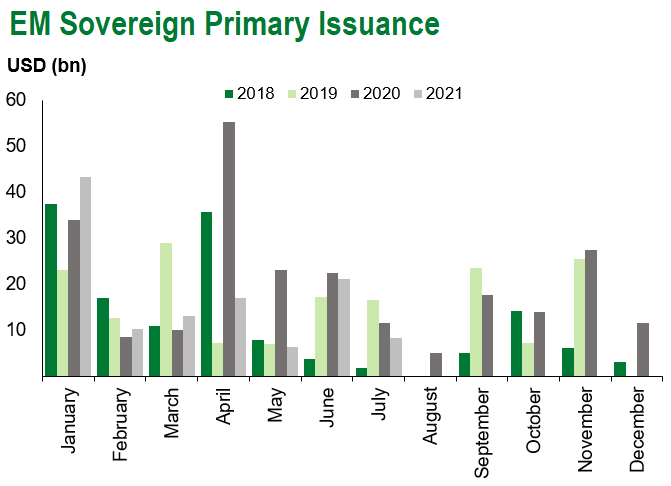
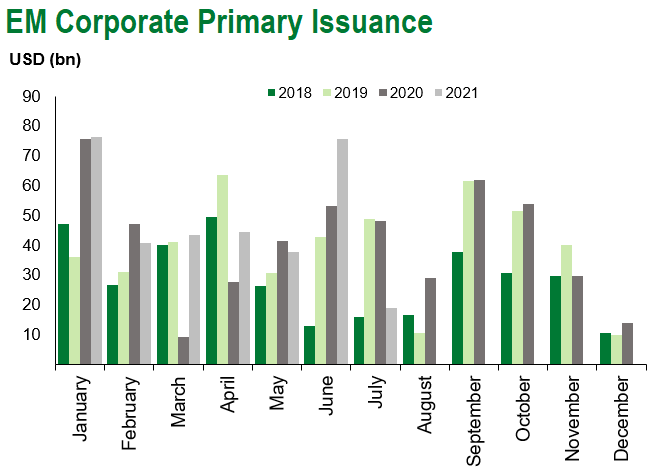
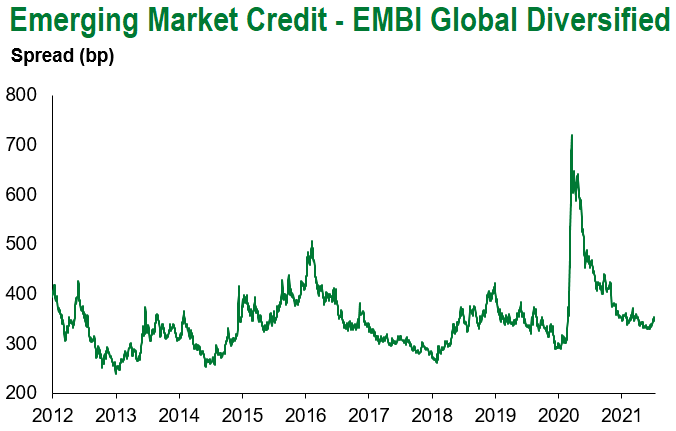
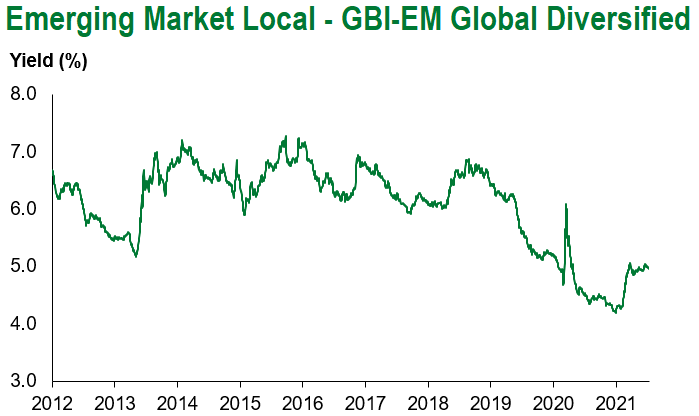
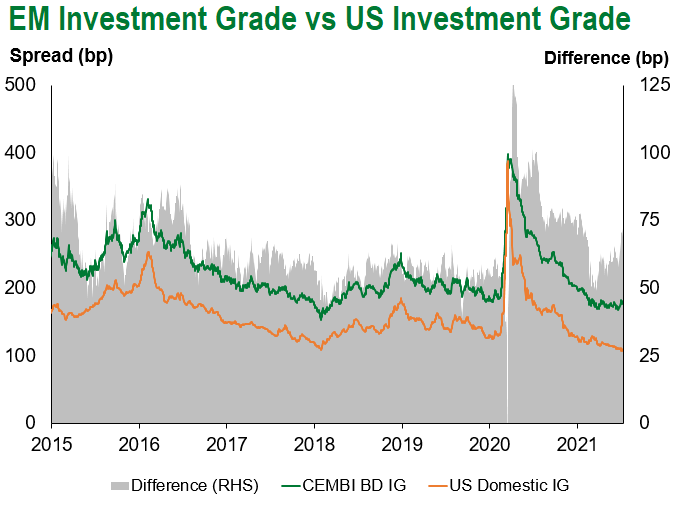
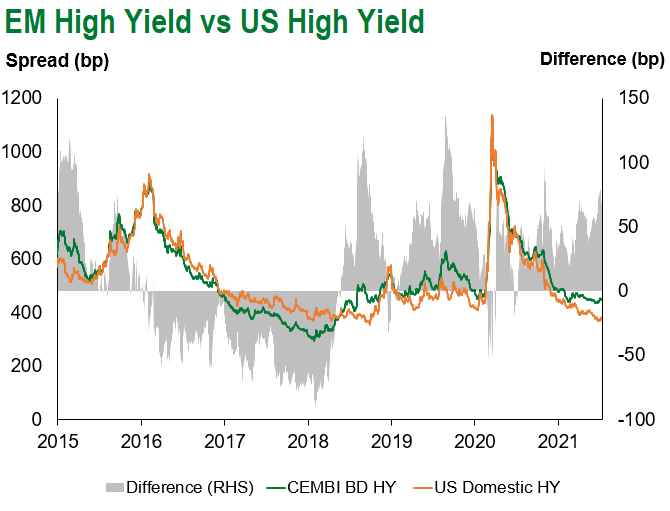
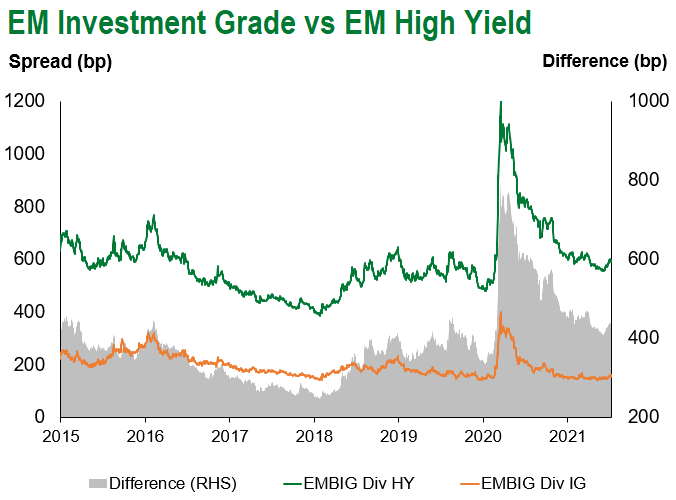
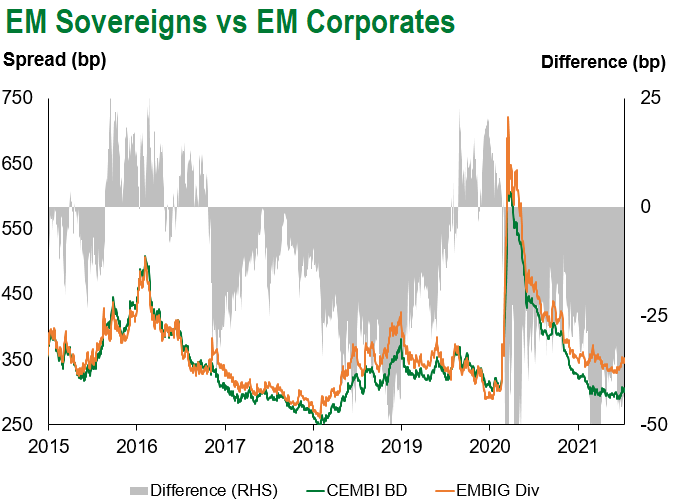
Emerging Markets Flows
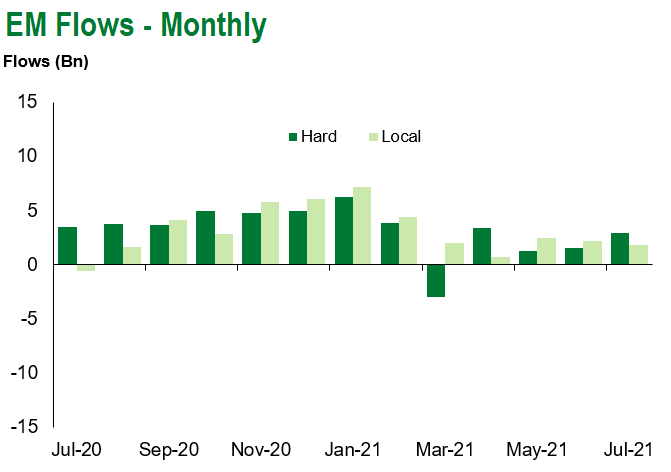
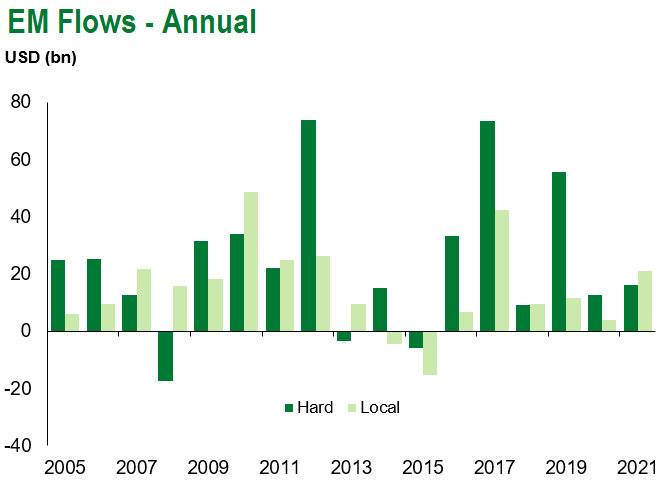
Source for graphs: Bloomberg, JPMorgan, Gramercy. As of July 16, 2021.
COVID Resources
Emerging Markets COVID-19 Case Summary
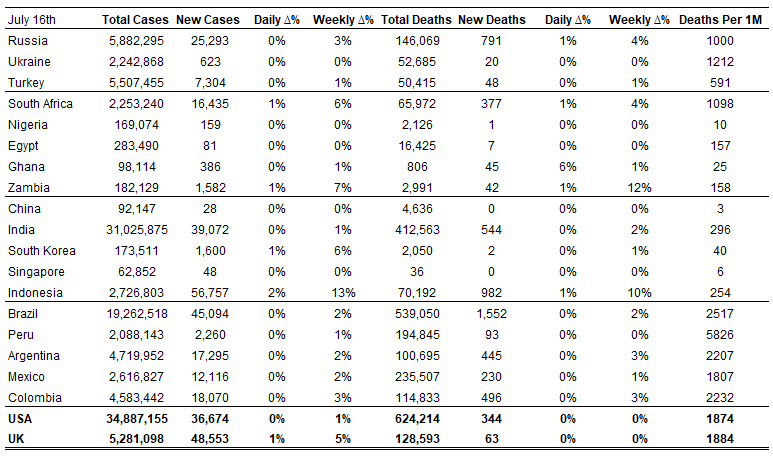
Source: Worldometer as of July 16, 2021.
Additional Crisis Resources:
Johns Hopkins COVID-19 Case Tracker
For questions, please contact:
Kathryn Exum, Senior Vice President, Sovereign Research Analyst, [email protected]
Petar Atanasov, Senior Vice President, Sovereign Research Analyst, [email protected]
Tolu Alamutu, CFA, Senior Vice President, Corporate Research Analyst, [email protected]
James Barry, Vice President, Corporate Research Analyst, [email protected]
This document is for informational purposes only. The information presented is not intended to be relied upon as a forecast, research or investment advice, and is not a recommendation, offer or solicitation to buy or sell any securities or to adopt any investment strategy. Gramercy may have current investment positions in the securities or sovereigns mentioned above. The information and opinions contained in this paper are as of the date of initial publication, derived from proprietary and nonproprietary sources deemed by Gramercy to be reliable, are not necessarily all-inclusive and are not guaranteed as to accuracy. This paper may contain “forward-looking” information that is not purely historical in nature. Such information may include, among other things, projections and forecasts. There is no guarantee that any forecasts made will come to pass. Reliance upon information in this paper is at the sole discretion of the reader. You should not rely on this presentation as the basis upon which to make an investment decision. Investment involves risk. There can be no assurance that investment objectives will be achieved. Investors must be prepared to bear the risk of a total loss of their investment. These risks are often heightened for investments in emerging/developing markets or smaller capital markets. International investing involves risks, including risks related to foreign currency, limited liquidity, less government regulation, and the possibility of substantial volatility due to adverse political, economic or other developments. The information provided herein is neither tax nor legal advice. Investors should speak to their tax professional for specific information regarding their tax situation.